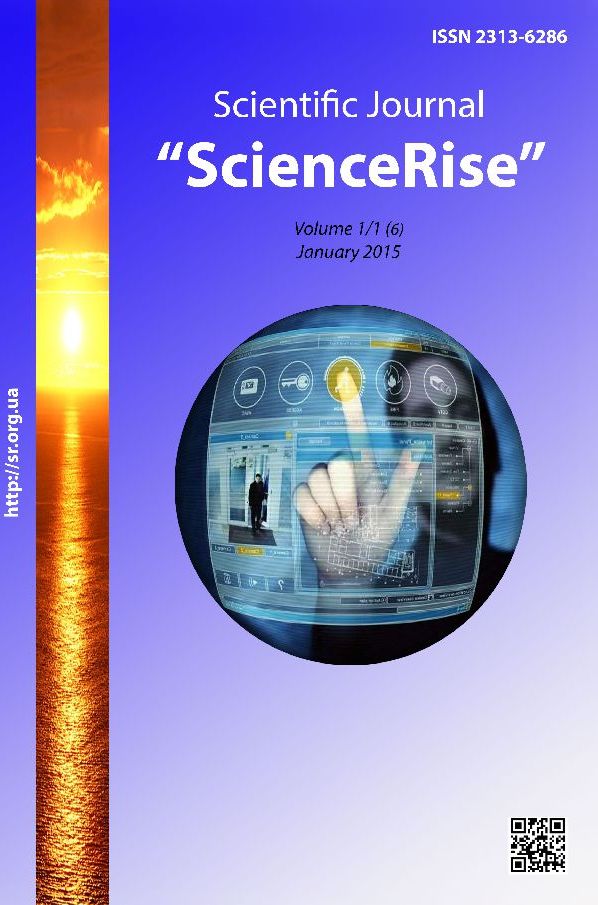Ранжирование административных районов харьковского региона по уровню экологического риска
DOI:
https://doi.org/10.15587/2313-8416.2015.35874Ключові слова:
экологический риск, потенциально опасный объект, объект повышенной опасности, чрезвычайная ситуацияАнотація
Представлено ранжирование территории Харьковской области по возможному экологическому риску от возникновения чрезвычайных ситуаций на объектах повышенной опасности. Создана карта уровня экологической опасности в районах области. Оценена плотность размещения потенциальных источников чрезвычайных ситуаций для районов области, дающая право с достоверной долей условности говорить о степени техногенной опасности территории исследованных районов
Посилання
Nacionalna dopovid pro stan tehnogennoi ta pryrodnoi bezpeki Ukrainy v 2013 roci (2013). Кiev: MNS, 542.
Mamontova, О. (Ed.) (2012). Statustuchnuy chorichnuk. Kharkiv: GUS Kharkivskoi obl, 578.
Zakon Ukrainy «Pro obektu pidvushenoi nebezpeku» (2001). Vidomosti Verhovnoi Radu (VVR), № 15, 73.
Barabashova, N. V. (2002) Ekologichna bezpeka promuslovo rozvunenogo regionu: pravovui aspekt. Donetsk: DonDAU, 227.
Begun, V. V. (2004). Bezpeka zhittediaylnosti (zabezpechennay socialnoi, tehnogennoi ta prurodnoi bezpeku): [navch. Posib]. Кiev: Universitet, 328.
Danilishin, B. М. (2004). Naukovi osnovu prognozuvannay prurodno-technogennoi (ekologichnoi) bezpeku. Кiev: Leks Dim, 552.
Bezpeka regioniv Ukrainu I strategiay ii garantuvannay (2008). Кiev: Nauk. dumka, 1, 392.
Doroguntcov, S. І. (2002). Derzhavne reguluvannay technogenno-ekologichnoi bezpeku v regionach Ukrainu. Ekonomika Ukrainu, 4, 70–76.
Kachinskiy, А. B. (2001). Ekologichna bezpeka Ukrainu: sistemnuy analiz perspektiv pokrashennay, Kiev: b.i, 311.
Yatsuk, А. V. (2001). Ekologichna bezpeka v Ukraini. Кiev: Geneza, 216.
Buts, Yu., Kraynyuk, O., Аndronov, V. (2010). The management by ecological risks and by ecological safety on basis of statistical approach. Riešenie krízových situácií v špecifickom prostredí: 15 medzinárodná vedecká konferencia, Fakulta špeciálneho inžinierstva ŽU, Žilina, 87–90.
Buts, Yu., Utkina, K. B., Kulik, M. I., Fylenko, V. V., Krainyk, E. V. (2012). Theoretical foundations of methodology for studying of emergency situation impacts on geosystems. Bezpečnostné Fórum 2012: V. Medzinárodná Vedecká Konferencia. Zbornic vedeckych a odbornych prac. Univerzita Mateja Bela, Banská Bystrica, 823–827.
Van Zelst, W. H., de Beurs, E., Beekman, A. T., Deeg, D. J., van Dyck, R. (2003). Prevalence and risk factors of posttraumatic stress disorder in older adults. Psychotherapy and Psychosomatics, 72 (6), 333–342. doi: 10.1159/000073030
Quarantelli, E. L. (1997) Ten criteria for evaluating the management of community disasters. Disasters, 21 (1), 39–56. doi: 10.1111/1467-7717.00043
Ruef, A. M., Litz, B. T., Schlenger, W. E. (2000). Hispanic ethnicity and risk for combat-related posttraumatic stress disorder. Cultural Diversity & Ethnic Minority Psychology, 6 (3), 235–251. doi: 10.1037/1099-9809.6.3.235
Schulberg, H. C. (1974). Disaster, crisis theory and intervention strategies. OMEGA – Journal of Death and Dying, 5 (1), 7–87. doi: 10.2190/ctrk-j0lc-k6ja-ej41
Monitogung ta ocinyuvannay ekologichnuh ruzukiv technogennogo pochodzhennay: analituchna dopovid (2012). Кiev: Nac. Instutut strategichnuch doslidzhen, 52.
##submission.downloads##
Опубліковано
Номер
Розділ
Ліцензія
Авторське право (c) 2015 Елена Владимировна Крайнюк, Юрий Васильевич Буц

Ця робота ліцензується відповідно до Creative Commons Attribution 4.0 International License.
Наше видання використовує положення про авторські права Creative Commons CC BY для журналів відкритого доступу.
Автори, які публікуються у цьому журналі, погоджуються з наступними умовами:
1. Автори залишають за собою право на авторство своєї роботи та передають журналу право першої публікації цієї роботи на умовах ліцензії Creative Commons CC BY, котра дозволяє іншим особам вільно розповсюджувати опубліковану роботу з обов'язковим посиланням на авторів оригінальної роботи та першу публікацію роботи у цьому журналі.
2. Автори мають право укладати самостійні додаткові угоди щодо неексклюзивного розповсюдження роботи у тому вигляді, в якому вона була опублікована цим журналом (наприклад, розміщувати роботу в електронному сховищі установи або публікувати у складі монографії), за умови збереження посилання на першу публікацію роботи у цьому журналі.

